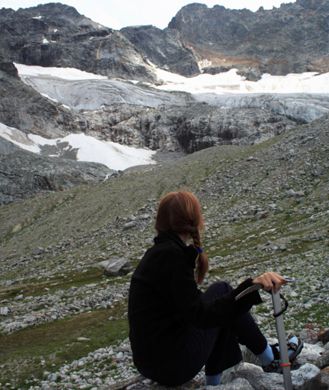
These aren’t your standard shop-till-you-drop, lounge-around getaways. Besides challenging your fitness level, the stunning locales here will unleash a sense of wonder and awe that you rarely get to experience. Nothing that rewarding comes easily, though-just getting to these adventure hotspots is an athletic feat in itself.
Inca Trail to Machu Picchu
Peru, South America
"Day four of the hike started at 3:45 a.m.," says Sultana Ali, 27, from Florida, who tackled the trek with two friends. "My calves ached as I climbed the last steep, narrow stairs to the Sun Gate. All I could see was the step in front of me until reaching the top. Then, as I walked through the archway, this ancient stone city, tucked amid the mountains, magically appeared below. When I first saw the ruins, I stood there frozen, tears rolling down my face."
Then she took off running full-blast down the last mile of trail leading to the site-with a 22-pound pack strapped on her back. “I was overcome with joy. I hadn’t opened myself up to such pure happiness in years,” says Ali.
Mystery surrounds this remote archeological gem. By the time Spanish colonists arrived nearby in 1532 A.D., the Incas had abandoned the settlement, though no one is sure why. The structures miraculously remained intact because the conquistadores, who were busy pillaging and destroying the villages they encountered, never found Machu Picchu, perched high up in the clouds at 8,860 feet.
What's more, since the Incas who built the Lost City (which remained undiscovered until 1911, when locals led an American scholar there) had no writing system, there's no hint as to why they chose to live on this isolated patch of Amazonian jungle. The stone-paved trail begins in the Quechua zone (at about 7,500 feet) and winds around mountains, reaching an altitude of 13,800 feet at Dead Woman's Pass before descending to Machu Picchu.
The Trek: 4 days (27 miles)
Book It: Peru Treks
Cost: From $425 plus airfare
Includes: Porter, all meals, transportation to the trailhead, entrance fees, an English-speaking guide, and tents (BYO sleeping bag)
Prime Time: High season spans April to November. If you want to avoid the crowds, aim to go during rainy season, between November and March.
Mt. Kilimanjaro
Tanzania, Africa
“At points, your quads are on fire, your knees are screaming, the sun’s beating down and you’re hiking in sand,” says Marybeth Bentwood, 32, from New York, who climbed Kili’s most challenging trail, the Western Breach, with her sister and cousin.
"The guides say, 'pole, pole,' (Swahili for slowly, slowly) as you trudge on. Then altitude sickness strikes. But with every step you muscle through, you're eliminating any self-doubt. Even when you're lying nauseous in a leaky tent with tissues blotting your bloody nose, you find humor in experiencing it all. You feel alive doing these things!"
Emerging from Tanzania's plains, Kilimanjaro contains three volcanoes-Shira, Mawenzi, and Kibo, the highest. The exact origins of the name are unknown, but legend has it that it means "Mountain of Light" or "Mountain of Greatness." Making your way to the snow-capped summit involves hiking through rainforest, highlands, desert, and meadows, and on most of the five main routes, you'll enjoy striking views of surrounding glaciers.
At 19,340 feet, Kilimanjaro is the highest peak on the African continent. It's so hard to breathe at such high elevations, though, that many trekkers never make it all the way up. Kilimanjaro National Park awards summit certificates to climbers who reach either Uhuru Point, at the very top, or Gillman's Point, which sits on the lip of the crater at 18,635 feet.
The Trek: 6 to 8 days (23 to 40 miles)
Book It: Zara
Cost: From $1,050 plus airfare
Includes: Porter, all meals, park fees, an English-speaking guide, and a tent and sleeping mat.
Prime Time: September, October, January and February are the driest, warmest months (although snow can fall year-round in the higher elevations). March to May and November to January are the wettest months (you can still trek then, but hiking conditions are less than optimal).
The Grand Canyon
Arizona, USA
“We got up at 5 a.m. to head down,” says Jillian Kelleher, from New York, who trekked into the Grand Canyon with her best friend. “After descending all day, then setting up our tent at 9 p.m., in the dark, we felt like Thelma and Louise-two women who could take on any adventure together.”
The 24-year-old admits the idea of climbing the canyon was daunting at first. "But when you're out in the wilderness feeling exhausted and realizing everything you forgot to pack, you learn to let go of what you can't control, take in the sights and have a good time."
This immense gorge, carved by the Colorado River over millions of years, is 277 miles long and more than a mile deep in places. The rushing waters have cut channels through the rock over the years and exposed four eras of geological history.
When sunlight hits the sedimentary rock layers, especially at sunrise and sunset, the spectrum of colors-red, orange, yellow, and green-is spectacular. As you hike the canyon, you'll also stumble onto dazzling outcroppings and craggy cliffs, bright pink and yellow cacti and cool, dark caves (perfect for taking refuge from the sun).
The Trek: 2-plus days. Try the South Kaibab trail (6.8 miles) down and Bright Angel Trail (9.3 miles) up for a nice loop.
Book it: Phantom Ranch Reservations; call 928-638-7875 for campsites.
Cost: The self-guided hike is free. You pay only for lodging (dorm or cabin; $36-$97) and meals ($24-39) at the bottom of the canyon.
Includes: Bed linens and towels. Dorms have bunk beds, bathrooms, and showers; cabins have private baths.
Prime Time: High season is April through October; rainy season begins in July with August being the wettest month, making for slippery rocks on the trail.
